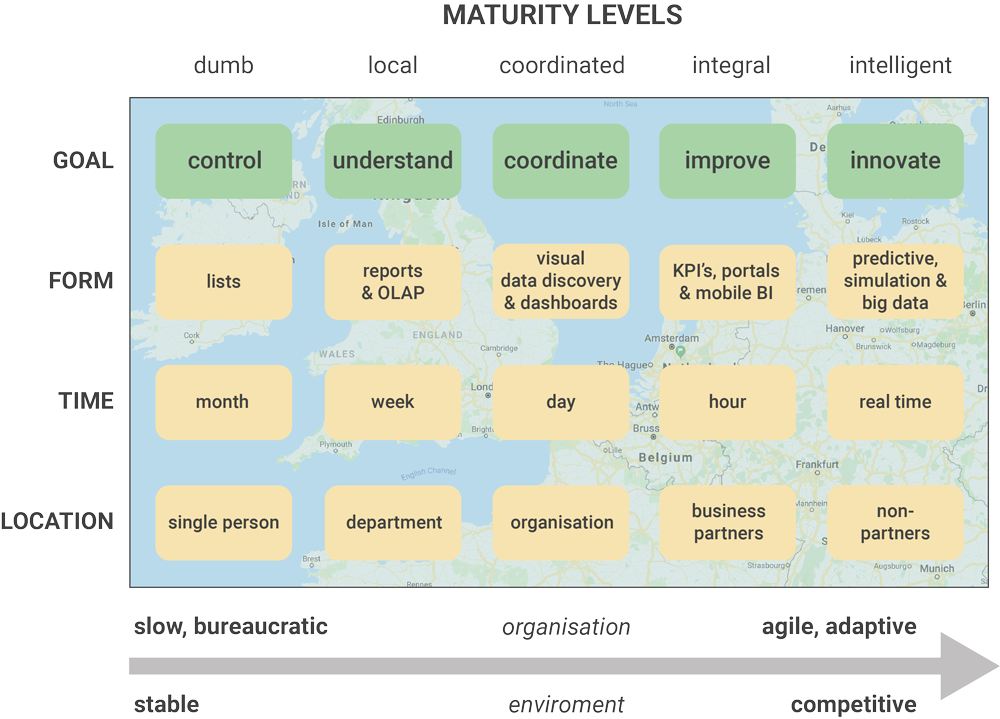Managing and steering smarter with an integrated BI Roadmap
As a Business Intelligence manager, advisor, or consultant, you aim to establish a clear path for Business Intelligence & Analytics – one that genuinely makes your organization smarter. A path with a clear destination, supported, shared, and understood by all stakeholders. Yet, you also recognize that developing a Business Intelligence roadmap is no simple task. Where do you currently stand? In this article, we present five key reasons to invest in a BI roadmap, highlight the importance of a BI vision, and outline the five steps to creating an integrated roadmap.
Five considerations for a BI Roadmap
Several practical questions immediately come to the forefront when developing a BI roadmap:
- Who will you involve in the BI roadmap process – and who won’t?
- What starting points will you use for the Business Intelligence roadmap?
- Has a clear vision for Business Analytics already been defined?
- How will you manage the variety of tools and BI software?
- What about funding from the business for the upcoming period?
In addition, no organization can afford to overlook the perspectives brought by Data Science. Passionned Group’s experienced Business Intelligence specialists are ready to support you in developing the ideal Business Intelligence roadmap, offering 100% independent BI advice and Business Intelligence training.
Without a vision for business intelligence, you’ll lose your way
You can’t develop an effective Business Intelligence roadmap without a clear, well-defined vision for BI. But what does that really mean? And why not jump straight into creating dashboards with QlikView or Tableau? Here’s the point: the core vision of BI is about ensuring that data and information are available in the right place within specific business processes – so they can immediately add value for your decision-makers. Strategically, tactically, and operationally.
Without this vision, even the most beautifully designed BI roadmap won’t get you to the right destination. You’ll lose your way. In essence, you’re missing the guiding beacon.
A strong example of a BI vision might be: “By 2023, we want to make company-wide, data-driven decisions. At every step in our processes, we will use data and analytics to drive continuous improvement.” Naturally, this vision must be fully endorsed and embraced by management and all teams.
Zero measurement indispensable for a business analytics roadmap
A solid Business Analytics roadmap starts with a clear baseline measurement. Where does your organization currently stand in terms of Business Intelligence maturity? Our proven BI model helps you determine this starting point – not only to establish a zero measurement but also to define a clear vision of your desired future state.
 Figure 1: Business Analytics maturity levels. This is how you assess your organization’s current and target state. Source: The Data Science Book.
Figure 1: Business Analytics maturity levels. This is how you assess your organization’s current and target state. Source: The Data Science Book.
It’s important to recognize the strong correlation between maturity levels and success in Business Analytics. Our three-day BI training is deeply grounded in this perspective.
Five principles in a business intelligence roadmap
Creating a successful roadmap requires adherence to several key principles. The following are essential:
- There is a broadly supported vision for Business Intelligence and Data Science.
- There is a clear connection to both the business strategy and the IT strategy.
- The current situation (IST) is no longer up for debate.
- The desired situation is ambitious, yet realistic.
- The roadmap outlines the path from the current to the desired state.
Even with these strong guiding principles, the ability to make continuous adjustments remains critical. In our experience, the agility of Business Intelligence teams and information products is often lacking. In today’s agile environment, BI itself must, of course, also be agile.
Create a roadmap in 5 steps
A Business Intelligence roadmap is developed by systematically following these five steps:
- Step 1: Take stock of the current situation. Through interviews, automated surveys, and an analysis of documentation and systems, we provide a comprehensive assessment of your current state.
- Step 2: Develop a vision. Our BI consultants collaborate with you to create and validate a vision for Business Analytics. This goes beyond aligning with your business and IT strategies – we also examine your business processes, products, and customers.
- Step 3: Place a dot on the horizon. In one or more workshops involving the BI team, information managers, data architects, management, and potentially other stakeholders, we define a clear future goal.
- Step 4: Identify the products and services to be delivered. We detail the desired future state in a presentation that outlines the BI products and services to be delivered. This includes BI governance, the required capacity and competencies of the BI team, and the necessary data infrastructure, such as a data warehouse and/or data lake.
- Step 5: Launch the programs. Based on the previous steps, one or more BI programs are initiated and broken down into individual projects with corresponding resource schedules.
Depending on your organization’s size and the complexity of its business model, the entire process of developing a solid roadmap can take anywhere from a few weeks to several months.
A business analytics roadmap cannot succeed without change management
To make meaningful progress in advancing Business Analytics maturity, attention to change management is essential. It’s a mistake to assume that technology alone will deliver results.
Our organizational advisors and consultants bring deep expertise in both Business Intelligence and change management. They understand the process-driven and organizational dimensions of Business Analytics and have extensive experience in developing effective roadmaps.
Without behavioral change, a BI roadmap falls flat
Business Intelligence aims to deliver the right information to the right person, in the right format, at the right time. When that goal is achieved, significant progress has already been made. While the structure of a roadmap may seem straightforward, its implementation is highly complex.
But even then, the real challenge begins: influencing the behavior of customers, managers, and employees using essential information and insights. Only when behavior changes in response to these insights can we truly speak of successful Business Intelligence.
Why is a focus on behavior so important?
The chart below, from a toy wholesaler, shows the percentage of orders placed outside the standard packaging unit by a specific store over the past thirteen months. In the warehouse, toy cars are packaged in sets of ten, yet the store consistently orders nine units each month. These deviations from the standard packaging create extra costs, as warehouse staff must manually repackage items.
What the wholesaler hopes to achieve is a shift in behavior: instead of ordering nine units each month for ten months, the store manager should order ten units nine times over the same period.
 Figure 2: Percentage of orders outside the standard packaging unit. Note: months are in Dutch.
Figure 2: Percentage of orders outside the standard packaging unit. Note: months are in Dutch.
Another example comes from a car damage insurer, which benefits when customers minimize damage to their vehicles. To monitor this, managers developed an indicator:
(damage amount per customer – deductible) / contract premium
If this value exceeds 100%, the insurer incurs a loss on the contract and must consider corrective measures.
 Figure 3: When the indicator exceeds 100%, the insurer incurs a loss on the contract. Note: months are in Dutch.
Figure 3: When the indicator exceeds 100%, the insurer incurs a loss on the contract. Note: months are in Dutch.
Competencies of managers and the customer relationship
The above examples clearly demonstrate the strong link between Business Intelligence and behavior. Yet, this connection is rarely addressed during BI implementation – despite its importance. Ultimately, the goal is to drive behavioral change among customers to achieve better, lasting performance.
Effective managers recognize this and ensure that such indicators are a standard part of their dashboards. Their aim is to analyze this management information as needed and use it to engage in meaningful dialogue with employees and customers – strengthening relationship management in the process.
Questions you can ask
- Is information consistently used for analysis, improvement, and targeted action?
- Are employees and managers held accountable for positive or negative performance and developments? How is this done?
- What competencies do smarter managers need?
- How is customer behavior monitored, and how is this communicated internally and with the customer?
In this context, it may be wise to assess the skills and competencies within your organization. If there are gaps in this area, targeted BI training is a simple yet highly effective way to quickly increase the return on your current and future Business Intelligence investments.
Don’t let this become an afterthought in your BI agenda – or your budget. Interested in focused training or a workshop on this topic? Click here for more information on PDCA.
Why choose Passionned Group?
- Our Business Intelligence specialists know all the ins and outs of the field
- We offer fixed pricing, no unexpected costs
- We are 100% independent of BI vendors and third parties
- We are the authors of The Data Science Book
- More than 200 satisfied clients have gone before you
Choose quality – get in touch with us
Curious how we can help you build a strong Business Intelligence roadmap and vision? Feel free to contact us for more information or to schedule an appointment. We’d be delighted to introduce you to our proven BI approach and expertise.
About Passionned Group
 The consultants and BI specialists at Passionned Group are experts in elevating Business Intelligence and Data Science. Every two years, we organize the Smartest Organization in the Netherlands competition and present the Dutch BI & Data Science Award™.
The consultants and BI specialists at Passionned Group are experts in elevating Business Intelligence and Data Science. Every two years, we organize the Smartest Organization in the Netherlands competition and present the Dutch BI & Data Science Award™.





